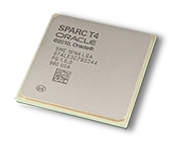This article is more than 1 year old
Oracle rises for Unix server push
SPARC T4 systems: Same skins, new brains
Oracle is taking the fight to Unix market leader IBM with its eight-core SPARC T4 processor and systems with rack, blade, and clustered systems – a full data center press.
The SPARC T4 processors, with an S3 core, were developed under the code-name "Yosemite Falls" and offer better performance than Oracle expected. They will be included in standalone rack and blade servers as well as in SPARC SuperCluster configurations that mimic the Exadata parallel database and Exalogic parallel application serving system, built on Intel x86 processors and running Linux.
The SPARC SuperClusters, which El Reg will discuss in detail in a separate story, are based on Solaris 10 or 11, and have sophisticated tunings in the Solaris and 11g database stack to make Oracle databases like an Exadata machine on the SPARC servers.
For now, let's just stick to the processor and the four servers that will be based on it. Many of the technical details of the SPARC T4 processor were divulged at the Hot Chips 23 conference at Stanford University (where Sun Microsystems was born) back in August.
The clock speeds of the processors were not divulged, but Oracle has been able to rev them up to 2.85GHz and 3GHz in the SPARC T4 systems, 73 and 82 per cent faster respectively than the previous 16-core SPARC T3 processors, which ran at a much slower 1.65GHz.

Oracle's SPARC T4 processor
While those SPARC T3 chips had eight threads per core (using the older S2 cores) and did a reasonable amount of work on some applications (like database, Java, and application serving), single-threaded code did not perform particularly well. So with the S3 cores, Oracle's chipheads added dynamic threading (in contrast to the static threading in the S1 and S2 cores) and also added something called the critical thread API. This allows applications to hog all the resources on an S3 core to boost the performance of a single-threaded application.
The SPARC T4 can switch between the thread-hog and normal modes on the fly. However, it is still unclear if recompilation will be necessary for this thread-hogging or will be done automatically. Hopefully, and almost certainly, it is the latter.
On the SPECint2006 benchmark, the SPARC T4 processor running at 3GHz has about five times the performance of the SPARC T3 chip running at 1.65GHz.

Larry Ellison can make the Sun rise again, apparently
The SPARC T4 processor has two DDR3 memory controllers, two PCI-Express 2.0 x8 peripheral controllers, and two 10 Gigabit Ethernet controllers on the die along with eight S3 cores. Each of those cores supports out-of-order execution and all the new threading, with eight threads per core, and also supports 18 cryptographic and hashing functions. Each S3 core has its own 16KB L1 instruction and 16KB L1 data cache, plus its own 128KB of L2 cache; the eight cores share a 4MB on-chip L3 cache, which is broken into two banks. Each core has its own floating point math unit as well.
At the launch event on Monday in San Francisco, Ellison gave a lecture of sorts on the benefits of parallel processing and how the parallel nature of Oracle's software, the SPARC T4 machines, the Exadata storage servers, and the InfiniBand network that glues it all together made the machines extremely scalable and fault tolerant.
But Ellison also reminded everyone that Oracle was also interested in selling standalone SPARC T4 systems and that the "gigantic step" in single-threaded performance on single machines would allow Oracle to upgrade its vast SPARC/Solaris server base.

Oracle CEO and co-founder Larry Ellison
"We wanted to give them a very, very smooth upgrade path," Ellison said. And as John Fowler, executive vice president of hardware engineering at Oracle, said later in the SPARC T4 rollout, Oracle is supporting both the current Solaris 10 and the impending Solaris 11 on these machines to also help in smoothing out that transition.
Oracle has not yet divulged pricing details on the SPARC T4 systems, but if it is aggressive with pricing – meaning keeping the machines about the same price or at a slight premium over the SPARC T3 machines – then it will certainly get the attention of SPARC/Solaris customers. It could also attract a few HP-UX and AIX shops too, if their workloads are modest enough to fit in a system with one, two, or four sockets. A SuperCluster is a bit of a harder sell than pushing an SMP or NUMA machine, but is becoming less so as every year goes by.
